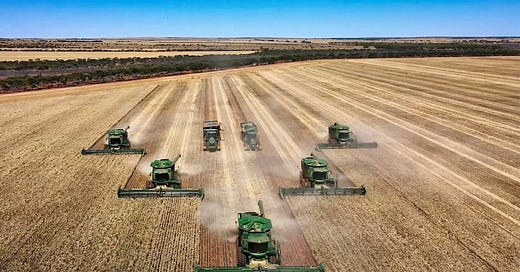What's wrong with the food system?
In Australia, finding food is as simple as getting in the car and driving to the nearest supermarket where you’ll find stocked shelves and endless choices.
For a long time, we’ve had no reason to think twice about where our food comes from. Two things are changing that.
First, COVID-19 led to empty supermarket shelves and for many was a wake-up call that our supply chains may not be as solid as we think.
Second, climate change and biodiversity loss are driving conversations on how our food and fibre are produced.
Impacts on nature
Farmers (and of course cows) are front and centre of the climate debate. Depending on who you ask, farming could be:
A major cause of climate change
The solution to climate change
A leading driver of deforestation and habitat loss
An opportunity to increase biodiversity
Could all of these things be true? Are farmers really who we should be looking at or is there more going on here? Here are some of the facts for Australia:
We’re a global leader in deforestation and mammal extinctions
In the last 200 years, we’ve lost nearly half of our forests
More than half of our land mass is used in some way for agriculture
Between 2010-2015, 63.8 million hectares of grassland became bare earth
Agricultural emissions make up 13-15% of our national total
Livestock and manure account for nearly 50% of total methane emissions
Changes in rainfall patterns and climate since 2000 have reduced farm profits by 23%
Of course, deforestation, loss of grasslands, and biodiversity decline can’t all be blamed on agriculture. In fact, across the country, the leading causes of deforestation are forestry and wildfires. It is a major cause though; over the last 5 years, two-thirds of deforestation in Queensland has been to support beef production.
With all these downsides, are we at least getting healthy and nutritious food?
Impacts on health
Well, the percentage of Australian adults who are overweight or obese increased to 67% in 2017-18 from 57% in 1995. The main drivers are poor diet and lack of physical activity. This isn’t to say that good food isn’t available, but it is an indicator that either many people can’t afford it, or they simply don’t know what to do with it.
Who’s responsible?
It’s important at this point to consider not just farmers but the food system as a whole. Farmers tend to cop a lot of the negative media and regulatory pressure while the other contributors (the retailers, wholesalers, ag chemical companies, machinery manufacturers, logistics companies, and consumers) often get a free pass despite the fact that these multinational behemoths are the ones who designed the system. It’s important to remember just that - this is a system with many parts and players.
To recap, our food system is a significant cause of deforestation, biodiversity loss, and carbon emissions, isn’t delivering the right kind of food to support a healthy human diet, and farm profits are going backwards. It’s worth asking, who’s benefitting here?
What can we do?
With all of the impacts our food system has on the environment and human health, consumers have started to notice and really care. Urban eaters aren’t satisfied anymore with a plate of meat and three veg. Food is part of identity now. We’re vegans and vegetarians and gluten-free, we do keto and carnivore diets, and we seek out food from regenerative farms.
Much of this is driven by our views on the impacts of agriculture on climate change and biodiversity. Food choices now speak to values, personality, and politics. And that’s a good thing because we have influence as consumers.
We need to look at the system as a whole, rather than focusing on individual parts. We need to look at who runs the system, who creates the incentives, and what we can do to support farmers to produce food and fibre in a more sustainable way, both environmentally and economically.
This means disrupting monopolies, supporting localised production, incentivising farmers to grow diverse crops and sequester carbon, and encouraging consumers to think about how their purchasing patterns affect the whole system.
The exciting part is that there are so many new ways of producing and distributing food (and old ways made new again) that can support local communities, get people re-engaged with their food source, and deliver healthy and nutritious food at a reasonable cost. This can all be done while reducing the impact our food production has on the planet.
Through this blog, I’ll be exploring some of these new methods like aquaculture, urban farming, agroforestry, regenerative grazing, and vertical farming, as well as ways that you can grow food at home even if you live in an apartment!
The important takeaway is that there are problems with the current system, but there are solutions too. From farmers to retailers to manufacturers to consumers, we all have a part to play.



